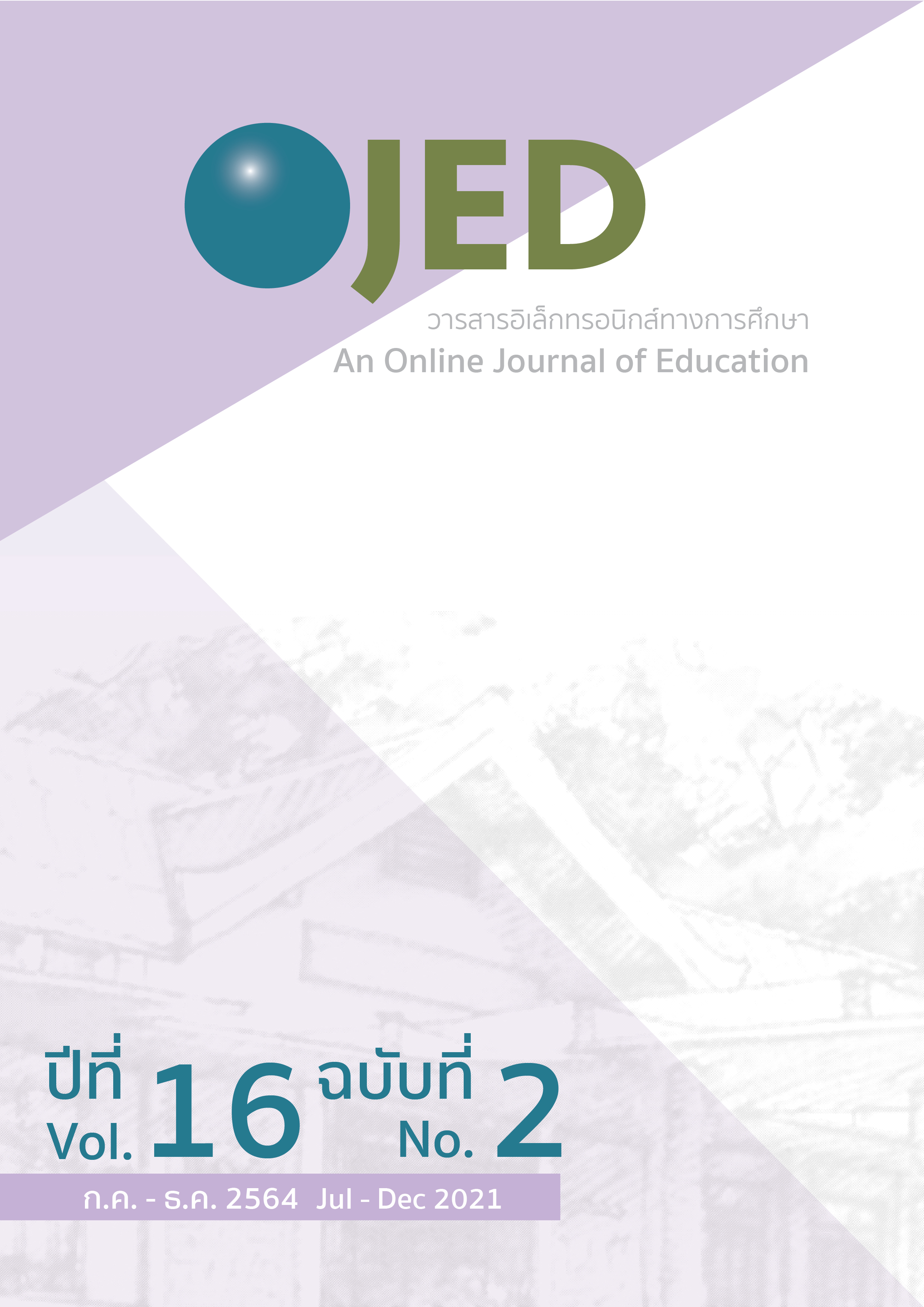Effects of Thai Language Instruction Using Interactive Writing Strategy and Balanced Literacy Approach on Written Expression Ability of First Grade Students
DOI:
https://doi.org/10.14456/ojed.2021.29Keywords:
Thai language instruction, ininteractive writing strategy, written expression ability, balanced literacy approach, first grade studentsAbstract
The purposes of this quasi-experimental research were: 1) to study the effects of Thai language instruction using interactive writing strategy and balanced literacy approach on written expression ability of first grade students; 2) to compare the effects of Thai language instruction between the experimental group and the control group. The samples were 50 first grade students studying in the second semester in the 2020 academic year at Watthatthong school under department of education Bangkok metropolitan administration. Room 1/1 was the experimental groups and 1/2 was the control group. Each consisted of 25 students. The experimental duration was 10 weeks. The data collection was through the writing expression ability test. Data analysis was statistically analyzed using arithmetic mean, standard deviation, T-test. The research finding were: 1) after the experiment, the experimental group had higher mean scores in written expression ability than those of before at 0.5 level of significance; 2) after the experiment, the experimental group had higher mean scores in written expression ability than those of the control group at 0.5 level of significance.
References
กุสุมา คำผาง. (2559). ผลของการจัดการเรียนการสอนเขียนสะกดคำภาษาไทยโดยใช้สมองเป็นฐานที่มีต่อทักษะการเขียนสะกดคำของนักเรียนในระดับประถมศึกษา. [วิทยานิพนธ์ปริญญามหาบัณฑิต ไม่ได้ตีพิมพ์]. จุฬาลงกรณ์มหาวิทยาลัย.
บันลือ พฤกษะวัน. (2538). มิติใหม่ในการสอนอ่าน. กรุงเทพมหานคร : ไทยวัฒนาพานิช.
ยศวีร์ สายฟ้า. (2557). รอยเชื่อมต่อการเรียนรู้ระหว่างชั้นเรียนอนุบาลและประถมศึกษา: ก้าวย่างที่สำคัญของเด็กประถมศึกษา. วารสารครุศาสตร์, 42(3), 143-159.
วรรณี แกมเกตุ. (2551). วิธีวิทยาการวิจัยทางพฤติกรรมศาสตร์. กรุงเทพมหานคร: โรงพิมพ์แห่งจุฬาลงกรณ์มหาวิทยาลัย.
สำนักทดสอบทางการศึกษา. (2561). รายงานผลการประเมินการอ่านออกเขียนได้ ปีการศึกษา 2559.สมุทรสาคร: บริษัท ที. เค. เอส. สยามเพลส แมเนทเม้นท์ จำกัด.
สำนักงานวิชาการและมาตรฐานการศึกษา. (2561). การดำเนินงานขับเคลื่อนสู่ความสำเร็จในการพัฒนาคุณภาพการเรียนการสอนภาษาไทย ปีงบประมาณ 2561. กรุงเทพมหานคร : โรงพิมพ์ตำรวจ สำนักงานตำรวจแห่งชาติ.
อารี สัณหฉวี. (2550). สอนภาษาไทยแนวสมดุลภาษา. กรุงเทพมหานคร: สมาคมเพื่อการศึกษาเด็ก
Button, K., Johnson, M. J., & Furgerson, P. (1996). Interactive writing in a primary classroom. The reading teacher, 49(6), 446-454.
Graham, S., & Harris, K. R. (2016). A path to better writing. The Reading Teacher, 69(4), 359-365.
Jones, O. D. (2015) Effects of writing instruction on kindergarten students’ writing achievement: An experimental study. The Journal of Educational Research, 108(1), 35-44.
McCarrier, A., Pinnell, G. S., & Fountas, I. C. (2000). Interactive writing: How language & literacy come together, k-2. Portsmouth, NH: Heinemann.
Roth, K., & Guinee, K. (2011). Ten minutes a day: The impact of interactive writing instruction on first graders’ independent writing. Journal of Early Childhood Literacy, 11(3), 331-361.
Rief, S. F., & Heimburge, J. A. (2007). How to reach and teach all children through balanced literacy. California: Jossey-Bass.
Tompkins, Gail E. (2018). Literacy for the 21st century : A balanced approach. Boston : Pearson Education.
Downloads
Published
How to Cite
Issue
Section
License
Copyright (c) 2021 An Online Journal of Education

This work is licensed under a Creative Commons Attribution-NonCommercial-NoDerivatives 4.0 International License.




